Last week I received an email from Silverprint announcing their relocation. A few years ago the shop moved from Valentine Place to London Road, but, as of last week, the London Road shop is closed. As the email and post on their website states that 85% of their sales are either via telephone or website, the necessity of having a central London premises for a largely mail order business begins to look much less viable, particularly given property prices in the capital. Being five years since I began this blog on film based photography this month, it's apt to reflect on this news today. Unlike in my post a year ago, Four years on, in terms of the state of available film not much significant has changed since then, so I won't examine this topic now. I was certainly one of the 15% of customers visiting the shop, now and again, fairly often over the past decade. I also buy a fair amount online, though never from Silverprint - London Road is a short walk from where I work - but buying online does mean spending money on postage of course, and there's no online equivalent to popping in opportunistically for a couple of rolls of film to shoot on the day.
In London there's now three shops that I use: Process Supplies; West End Cameras (who have recently lowered the prices of some films they stock); and for the lowest prices on Ilford film (35mm and medium format) KVJ Fairdeal in Whitechapel (their website is Total Blank Media) which I first used as a student twenty-two years ago. Of course, a good shop is more than just a series of shelves full of products: Silverprint in London Road had an exhibition space, a useful noticeboard, and hosted events, which will no doubt be missed by many. Incidentally, I found a short reminiscence on the Re:PHOTO blog, about halfway down the post Still Occupied. The Goldfinger Craftbook mentioned in the post isn't now available on the Silverprint website, but when I started developing films again after a break ten years ago it was useful in understanding the processes involved.
When I started this blog five years ago, I wasn't sure if I would be able to sustain it, or even what exactly it would be, and perhaps many of the topics of the posts I've written are of very limited interest (there are many pre-war camera posts and a few about obscure discontinued films). However, on a self-referential note, this month has also seen the blog pass 100,000 views, a small milestone for a small blog I've been writing, when time and circumstances allow, out of my own personal interest in the subject.
Monday 22 February 2016
Wednesday 17 February 2016
Kiev-4
 |
| Kiev-4 rangefinder with Jupiter-8M f2 5cm lens |
The first Kiev rangefinders are named Kiev II and Kiev III to correspond with the Contax II and III: both models designated III have an uncoupled selenium lightmeter. The Kiev cameras were then slightly modified by the addition of a PC socket for flash: these became the IIa and IIIa. The next iterations were the Kiev-4 (with light meter) and 4A (without meter), followed by the last cameras in the series, the 4M and 4AM. (There was also a Kiev-5, a comprehensive redesign from the Contax-based original, which had a relatively short production run). All the different models appear to have overlapping production dates, according to the details provided on SovietCams.com; the 4M and 4AM variants of the Kiev rangefinder were produced until the mid-1980s, remarkable for the fact that, although there were many changes during production, it was still recognisably Zeiss Ikon's camera of fifty years earlier.
Zeiss Ikon produced the first Contax rangefinder in 1932 as a direct response to the Leica. Later known as the Contax I, it was very much a work in progress with numerous changes to the camera while in production; the Contax II from 1936 demonstrated Zeiss Ikon's determination to better Leica in almost all specifications (Cameraquest has a detailed comparison between them), yet the Contax doesn't have the same legendary name or status that the Leica has achieved. Perhaps this is in part due to the post-war legacies of both companies: Leica concentrated on their famous rangefinder, aimed at a small section of the luxury camera market, while Zeiss Ikon AG had a large product range, attempting to cover all aspects of consumer photography, and were essentially put out of business by Japanese competition. Although Zeiss Ikon AG were relatively quick to produce the post-war Contax in 1950, as a camera system it wasn't subsequently supported and developed, while Leica produced the M3 in 1954 - which incorporated a number of features that the pre-war Contax had, with improvements in other areas.
In part due to cost, I'd never bought into the cult of the Leica. However, the Contax, and probably even more, the Kiev rangefinders have a following of their own - for example, there's a wealth of websites dedicated to the Kiev (see bottom of this post): the Kiev gives one a taste of the Contax at a fraction of the price (similarly, with Leica, there are also the FED and Zorki copies; and both the Contax and Leica have numerous cameras inspired by their designed, sometimes combined into one - like the Nikon). Late last year, a box arrived from Ukraine containing a Kiev rangefinder: I'd researched the model I wanted, and spent some time looking online before buying. Unsurprisingly, the Kiev is still largely to be found in its country of origin, and, although not expensive, the postage was half the price of the camera.
I'd found a relatively early version of the Kiev-4 model. The first two letters of the serial number designate the year of production: my camera dates from 1960, with a the standard Jupiter-8M 5cm f2 lens from a year earlier. According to Fotoua, this Kiev-4 is a Type 2b, defined by not having a stop bolt on the accessory shoe, and the "lines of rigidity" on the meter (the raised 'T' shape between the accessory shoe and the meter window). My initial impressions were that I had been expecting the camera to be bigger - it's smaller than an SLR such as the Canon A-1 for example - but also, externally at least, the quality and finish of the body are of a high standard; the aluminium lens barrel less so. Many of the comments in this post relating to the functions of the Kiev-4 are probably equally applicable to the design of the original Contax II/III, including some of its quirks, with a few caveats.
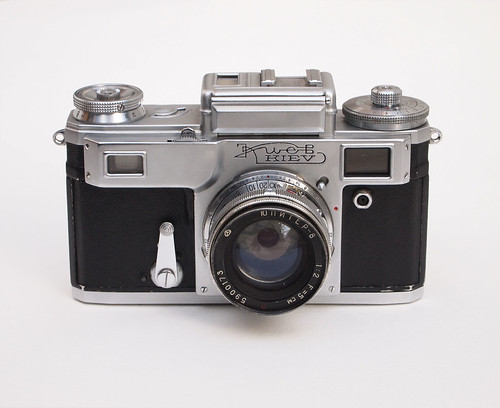 |
| Kiev-4 with Jupiter-8M f2 5cm lens |
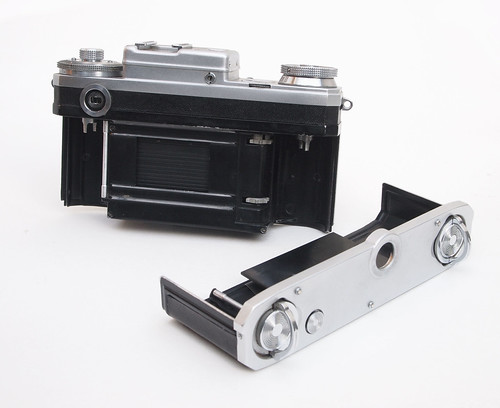 |
| Kiev-4 with back removed for loading |
My camera came with a metal removable spool with a central slot for the film leader, and to use this would mean either cutting the film leader to a point, or taping it to the spool. Neither approach is entirely impractical but perhaps undesirable when out in the field. Initially, I attempted to use two 35mm cassettes, with the take-up cassette made up in mirror image, much like with the Belomo Agat18k, but this first roll of film tore as the sprocket holes in the film did not quite match up with the sprocket teeth.
 |
| Take up chamber with film advance claw |
 |
| Left to right: original Kiev spool; modified solid spool; unmodified spool |
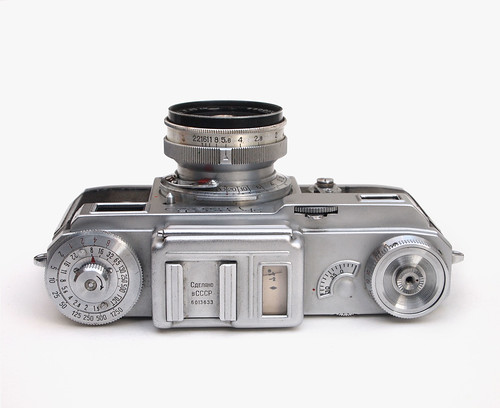 |
| Kiev-4 rangefinder, view of top plate |
The Contax/Kiev lens mount has an internal and external bayonet: the internal bayonet is used by the 50mm lenses and has a built-in helical; other lenses use the external mount and this means that the entire 5cm Jupiter-8M lens rotates as it focus. The lens aperture ring thus rotates away from the user until it can no longer be seen from the top of the camera. Some 50mm lenses had the aperture scale engraved twice around the lens to ensure it's always visible, but my lens has only one scale. As the 50mm lenses do not focus themselves, the internal bayonet mount also has focus and depth of field scales engraved around it. There is an infinity lock on the focus, which has two release levers: the tab above the focus wheel on the body, and the sliding pin by the lens itself. To change lenses with the internal bayonet, the lens must be locked at infinity.
For writing this blog post, I've only been using the standard Jupiter-8M f2 5cm lens that came with my camera, but Arsenal duplicated the Contax range of Zeiss lenses, with the f1.5 50mm lenses - both the Zeiss Sonnar and the Jupiter-3 version - being most sought after and commanding the highest prices. With the 50mm lenses, both the wheel on the body or rotating the lens barrel can be used to focus the lens once the infinity lock has been released. It's not recommended to use the focus wheel on the body for other lenses due to their inertial weight. The rangefinder is clear and easy to use (the viewfinder has no frame lines or parallax indication, merely the square superimposed rangefinder patch), and I did find that I was deliberately choosing subjects to make use of its accuracy, isolating near objects and using wide apertures to throw backgrounds out of focus. The Jupiter-8M lens has a nine-bladed aperture diaphragm that no doubt helps in the smooth rendering of out-of-focus areas, such as in the shot below.
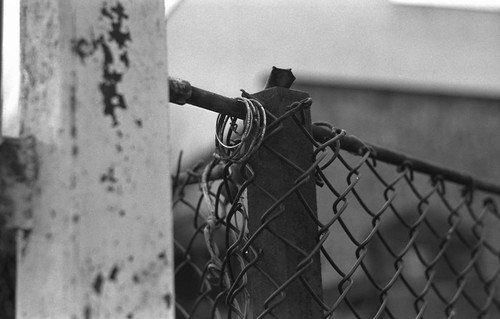 |
| Kiev-4 with Adox Silvermax |
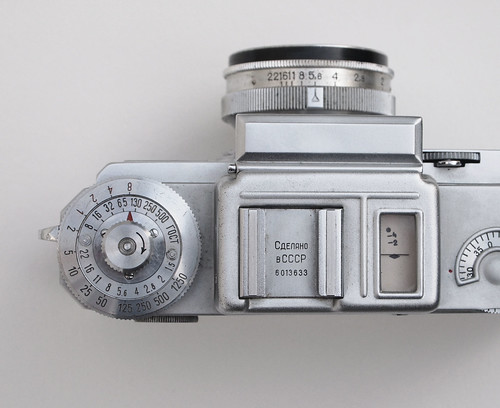 |
| Kiev-4 lightmeter and exposure calculator |
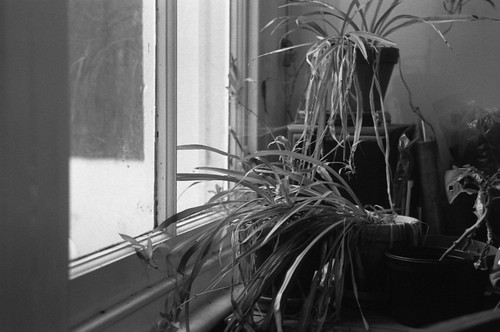 |
| Kiev-4 sample image on Ilford HP5 Plus |
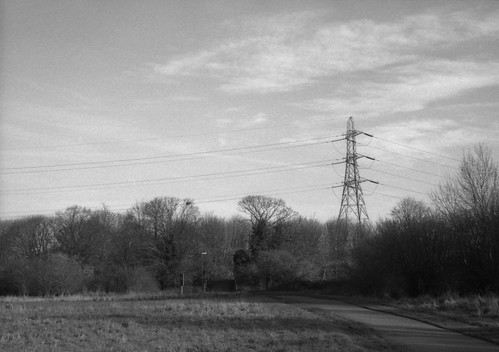 |
| Kiev-4 sample image on Ilford FP4 |
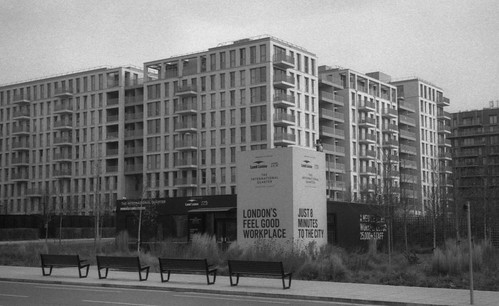 |
| Kiev-4 sample image on Ilford Mark V Motion Picture Film |
 |
| Kiev-4 sample image on Foma Retropan 320 |
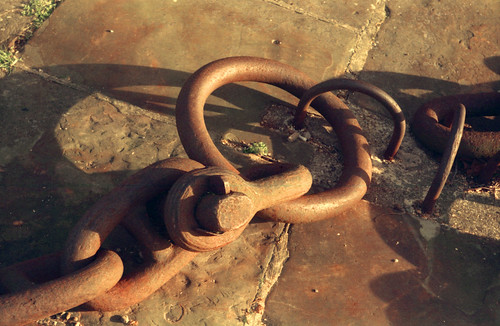 |
| Kiev-4 sample image on expired colour print film |
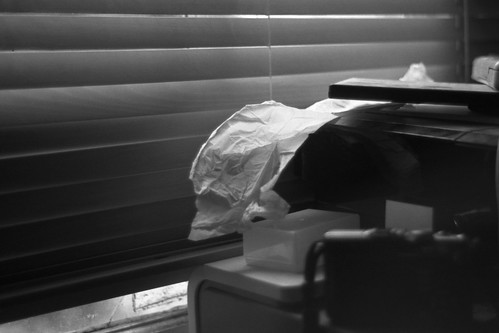 |
| Kiev-4 sample image on Adox Silvermax |
Sources/further reading:
SovietCams.com overview of the Kiev/Contax
Kiev-4 manual translated into English
Kiev Survival Site
Kiev-4 schematics on USSRPhoto
Kiev-4 on Photoethnography
Kiev-4 on Matt's Classic Cameras
Kiev-4 on Camerajunky
Kiev-4 on Early Photography
Kiev-4 on Classic Cameras
Contax manuals from Butkus.org
Subscribe to:
Posts (Atom)
